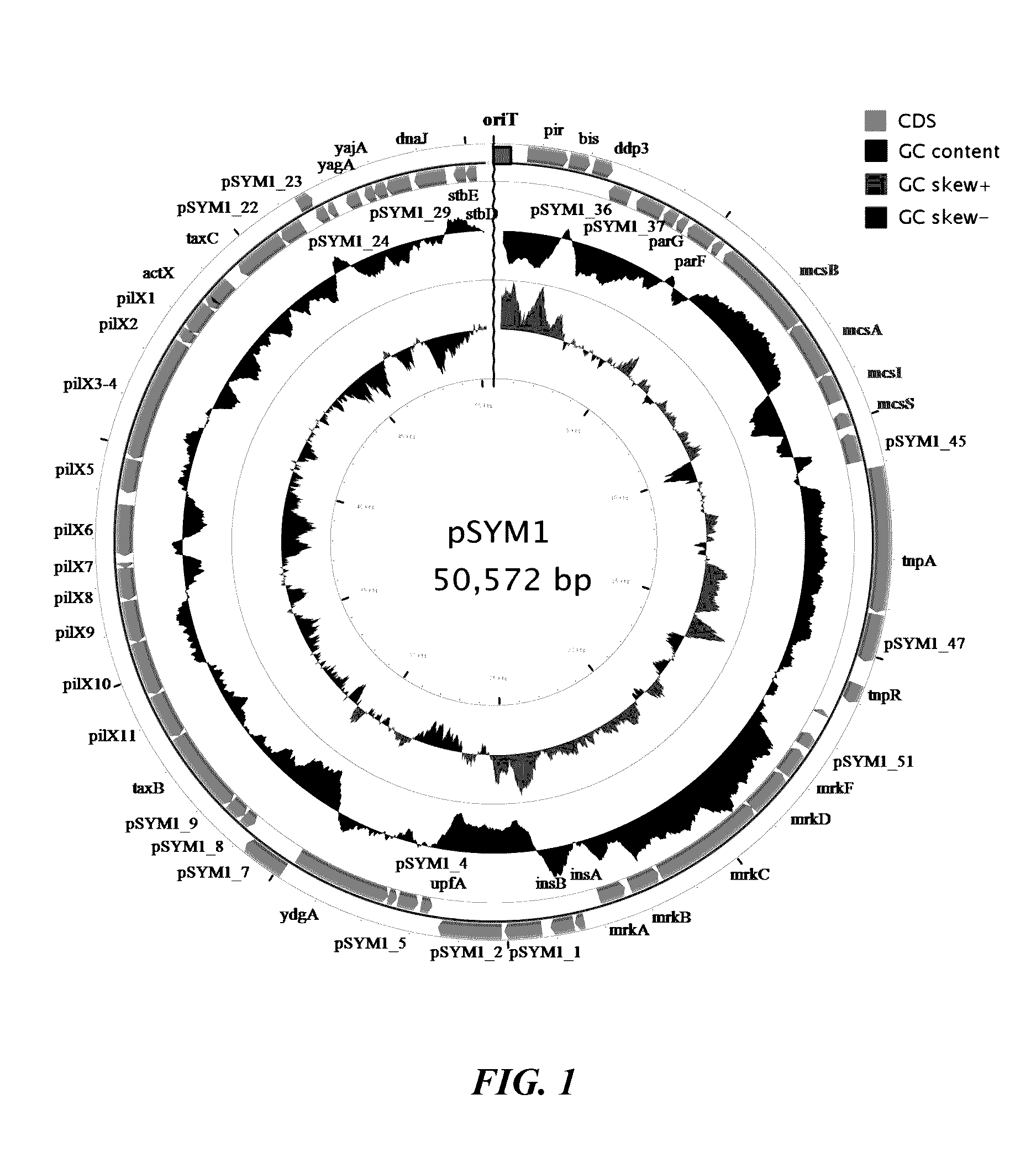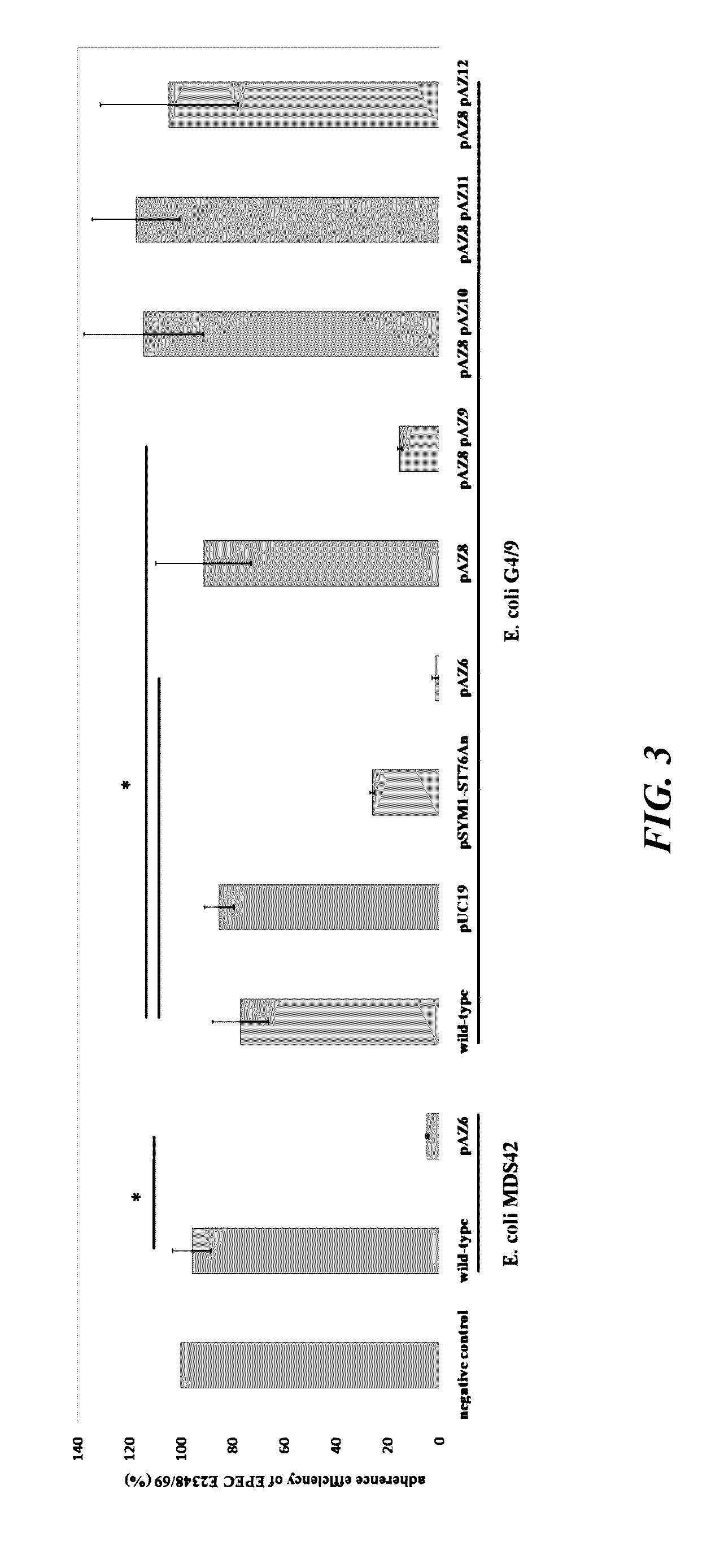Bacterially formed microcin s, a new antimicrobial peptide, effective against pathogenic microorganisms, e.g. enterohemorrhagic escherichia coli (EHEC)
a technology of microcin and sulfonamide, which is applied in the field of isolated polypeptides and nucleic acid molecules encoding microcin s polypeptides, can solve the problems of increasing the difficulty of esbl therapy, the emergence of pathogens resistant to classical antibiotics, and the inability to induce allergies, etc., to achieve the effect of not inducing allergies
- Summary
- Abstract
- Description
- Claims
- Application Information
AI Technical Summary
Benefits of technology
Problems solved by technology
Method used
Image
Examples
example 1
Bacterial Strains and Growth Conditions
[0217]Bacterial strains used herein are listed in Table 3.
TABLE 3Bacterial Strains UsedRelevantStrainGenotypeOriginE. coli Nissle 1917wild-typeMutaflor ®E. coli G1 / 2awild-typeSymbioflor 2 ®,SymbioPharmE. coli G3 / 103wild-typeSymbioflor 2 ®,SymbioPharmE. coli G4 / 9awild-typeSymbioflor 2 ®,SymbioPharmE. coli G5awild-typeSymbioflor 2 ®,SymbioPharmE. coli G6 / 7awild-typeSymbioflor 2 ®,SymbioPharmE. coli G8awild-typeSymbioflor 2 ®,SymbioPharmE. coli MDS42K-12 multiplePosfai et al. (2006)deletion strainEmergent Properties ofReduced-GenomeEscherichia coli.Science 312:1044-1046.EPEC E2348 / 69 O127:H6Ampr (pUC19),Donnenberg & KaperKanar (pUC4k)(1992) Enteropathogenicor CmrEscherichia coli. Infect.(pACYC184)Immun. 60: 3953-3961.EHEC 86-24 O157:H7stx2, eaeA,Griffin et al. (1988)EHEC-hlyA,Illnesses associated withastA, SmrEscherichia coli 0157:H7infections. A broadclinical spectrum.Ann. Intern. Med.109: 705-712.EHEC O104:H4wild-type, stx2,human isolate, Dresde...
example 2
Identification of a Microcin-Encoding Gene Cluster in E. coli G3 / 10
[0218]The genomes of six E. coli: E. coli G1 / 2, G3 / 10, G4 / 9, G5, G6 / 7 and G8. were sequenced. Annotation revealed no known microcin within the genome of E. coli G3 / 10. E. coli G3 / 10 contains a large conjugative plasmid pSYM1 (FIG. 1) with a size of 50.6 kb. The plasmid is 99% identical to plasmid pMAS2027 of an uropathogenic E. coli isolate. Moreover, it contains a 10 kb insertion fragment, but BLAST analysis revealed only uncharacterized and unnamed genes. To identify the origin of bactericidal action it was tried to cure the strain E. coli G3 / 10 from its megaplasmid pSYM1. Despite performing many of common curing procedures, for example mitomycin C or heat treatment, the strain could not be cured. Therefore, plasmid pSYM1 was transferred to E. coli G4 / 9 by conjugation. To allow a screening of conjugants, at first an ampicillin resistance cassette was integrated into pSYM1 resulting in pSYM1-ST76An. The resulting E....
example 3
Functional Characterization of Microcin S and Elucidating its Self Immunity
[0219]Bacterial adhesion is a crucial first step of many infectious diseases. Therefore, a test system quantifying the inhibition of adherence to human intestinal epithelial cells is suitable to demonstrate a beneficial effect to the host. In a first experiment, confluent monolayers of CACO-2 or LOVO cells were pre-incubated with bacterial test strains EcN, E. coli G3 / 10, E. coli G4 / 9 or E. coli G4 / 9 pAZ6 at an MOI of 100:1 E. coli to host cells. After two hours of incubation, cells were washed and infected with EPEC E2348 / 69 using an MOI of 100:1 EPEC to host cells. E. coli G3 / 10 and E. coli G4 / 9 pAZ6 were capable of inhibiting EPEC adherence similar to EcN. EcN adherence inhibition was shown to be dependent on the strains microcins activity. Adherence efficiency in % are expressed as adherence of EPEC relative to adherence without any pre-incubation (negative control), which is set 100%. The data are the me...
PUM
| Property | Measurement | Unit |
|---|---|---|
| Tm | aaaaa | aaaaa |
| temperature | aaaaa | aaaaa |
| temperature | aaaaa | aaaaa |
Abstract
Description
Claims
Application Information
 Login to View More
Login to View More - R&D
- Intellectual Property
- Life Sciences
- Materials
- Tech Scout
- Unparalleled Data Quality
- Higher Quality Content
- 60% Fewer Hallucinations
Browse by: Latest US Patents, China's latest patents, Technical Efficacy Thesaurus, Application Domain, Technology Topic, Popular Technical Reports.
© 2025 PatSnap. All rights reserved.Legal|Privacy policy|Modern Slavery Act Transparency Statement|Sitemap|About US| Contact US: help@patsnap.com



